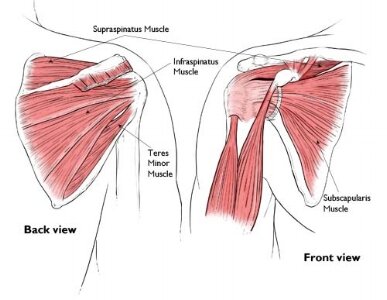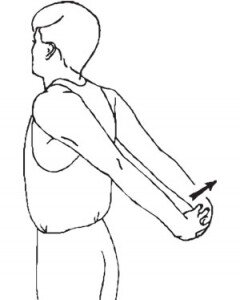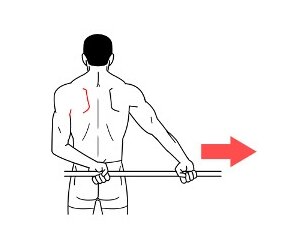Stretches for Sore Shoulders and Rotator Cuff Injuries
A number of patients coming into our Wellington Chiropractic studio are complaining of shoulder pain. We have put together some great tips to help resolve some shoulder discomfort at home.
Pain around the shoulder joint and shoulder blades can be distracting when you are trying to work and make it difficult to sleep, but chiropractic and simple shoulder stretches can help those muscles to stay strong and flexible to reduce pain and avoid injury.
Some people come in with severe shoulder pain where they have trouble lifting their arms up or simply can not move them at all. This can be the case with frozen shoulder and rotator cuff injuries.
Rotator Cuff
The rotator cuff is a group of four muscles and the tendons that surround the shoulder joint, helping to stabilise it and allowing it to move. Damage to this area can occur because of injury, incorrect repetitive shoulder movements and overuse. They are common with athletes and elderly who’ve had a fall. The pain is usually described as a dull ache deep in the shoulder and is often accompanied by arm weakness. Lying on the affected side worsens the pain and the injury can disturb sleep and activities of daily living.
Damage to the rotator cuff causes a number of issues:
Pain to the shoulder joint limits its range of motion.
The muscles no longer make the small adjustments within the joint to allow the bone to move smoothly.
Movement is limited by inflammation and the fluid accumulation it causes.
Arthritis and calcium deposits that form over time further limit range of motion.
If it is not treated, damage to the rotator cuff can lead to permanent stiffness or weakness and even progressive degeneration of the shoulder joint. Both out of necessity due to pain, and in order for your shoulder to recover, you may need to modify your work activities, reducing lifting or reaching over the head in particular and allowing the joint to rest a little. However, it is important not to over rest an injured shoulder. Keeping the shoulder immobilised for a long period of time may cause the connective tissue around the joint to thicken and tighten the shoulder - see Frozen Shoulder below. Do not try to work or play through the pain, but do keep up a level of movement that will allow the shoulder to strengthen. The exercises below are ideal for this.
Frozen shoulder
A frozen shoulder involves, stiffness, pain and limited range of movement in your shoulder. Symptoms usually begin gradually and worsen over time. Frozen shoulder can develop from overuse, after having an injury, or recovering from a surgery which has prevented you from moving your arm. The pain and stiffness is caused by the tissues around the joint stiffening and scar tissue forming. Many shoulder problems can progress to a frozen shoulder if you do not work to keep full range of motion; so we suggest adding some shoulder stretches to your chiropractic care for a full recovery.
Six Simple Shoulder Stretches:
These exercises will help you to stretch out key muscles in the rotator cuff and surrounding shoulder area. Each stretch has been chosen to target a specific muscle - though they will help with a number of muscles and tendons at once! Repeating these exercises regularly can help to relieve pain and keep muscles strong and flexible to prevent pain, stiffness and injury. These can be done in a gentle manner, to progressively rebuild your full range-of-motion. If you feel pain do not push through, rest.
Supraspinatus
The supraspinatus muscle is one of the key muscles involved in shoulder problems. To stretch out the supraspinatus, place your right hand behind your back and reach up between your shoulder blades. Hold for 1 minute while taking deep breaths; swap arms and repeat.
Infraspinatus
To stretch your infraspinatus put right forearm horizontally across your lower back, knuckles facing the spine. With left arm going across your front, hold your right arm just above the elbow and pull your elbow towards your front. Hold for 1 minute while taking deep breaths; swap arms and repeat.
Pectoralis
This stretches out muscles in your chest connecting to your shoulders.
Interlock your hands behind your back, keeping your arms straight, raise them as high as you can until you feel a comfortable stretch through your chest and biceps. Keep your body in an upright position. Hold 20-30 seconds. Repeat 2-3 times.
Deltoid
The cross over arm stretch is a simple way to stretch out your deltoid muscle. Bring your left arm across the front of your body at shoulder level. With your right hand, hold your left arm just above the elbow and gently pull across your chest until you feel the stretch across the back of your shoulder and upper arm. Hold for 1 minute while taking deep breaths; swap arms and repeat.
Teres Major & Minor
The overhead arm stretch is an excellent stretch for relieving tension in your shoulders and stretches out the Teres muscles as well as surrounding muscles. Raise your left arm above your head, bend at the elbow reaching behind your head so your hand touches the your right shoulder blade. The further you push your elbow and move your hand down your upper back, the more you will feel this stretch. You may find it easier to use your right hand to assist, but don’t push too far too fast. Hold for 1 minute while taking deep breaths; then swap arms and repeat. It can also help to bend the upper body way from the side being stretched, just ensure you are bending sideways and not twisting.
Subscapularis
To stretch the subscapularis, find a light stick, a golf umbrella will suffice, and hold it behind your back with your left hand. Gently grasp the other end with your right hand. Pull the stick horizontally to your left side, such that you feel a pull in the front of your shoulder, but not pain. Hold for 1 minute while taking deep breaths; rest then swap sides. Repeat. Avoid leaning over or twisting to the side when pulling the stick.
Try these exercises a couple of times a day to keep your shoulders strong and muscles flexible. For more shoulder exercises check out our other blog post Relief for neck pain and arm numbness (TOS).
If you would like to book an appointment we have two locations.
-Be Well Chiropractic Wellington
-Be Well Chiropractic Wairarapa
10 minutes from Carterton and it is your closest chiropractor to Featherston.









